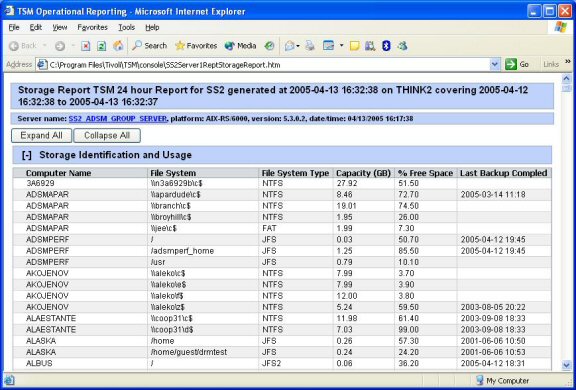| Tool Mentor: TSM - Assign and Control Delivery Resources |
 |
|
| Related Elements |
|---|
ContextTool mentors explain how a tool can perform tasks, which are part of ITUP processes and activities. The tasks are listed as Related Elements in the Relationships section. You can see the details of how processes and activities are supported by this tool mentor, by clicking the links next to the icons: DetailsIBM® Tivoli® Storage Manager manages two different types of storage resources, online and offline. Online storage is storage that is attached to systems that are located on local and storage area networks (LANs and SANs) typically in support of business applications. Offline storage is the storage that Tivoli Storage Manager manages internally, such as disk and tape, which it uses to store and manage copies of data that are on the online storage. Should an online storage device fail if a data error occurs or if someone accidentally deletes a file, the offline copy of that data can be copied (restored) to online storage. When Tivoli Storage Manager is configured to protect online storage, an administrator can use Tivoli Storage Manager to generate reports, that will help to identify the characteristics of that storage such as the number, type, capacity, utilization, and time of last completed backup. It can provide information down to the file and object level for cases where the data is associated with online applications such as database and mail servers. Figure 1 provides an example of a report that shows information about online resources.
Tivoli Storage Manager can be configured to automatically provision and manage the offline storage resources it uses and can automatically increase capacity for both new requests and normal operations. For example, Tivoli Storage Manager provides space triggers that will monitor the capacity and utilization of its own database, recovery log, and storage pools so that when utilization thresholds are exceeded, the capacity will be expanded to ensure continuous operation and to allow for efficient space utilization of the offline storage that it is managing. One of the key features of Tivoli Storage Manager is what it calls "progressive incremental" or "incremental forever" backups. Unlike other backup products that require periodic full backups, Tivoli Storage Manager requires only incremental backups. The first time a backup is performed, all of the data is new to Tivoli Storage Manager and so it is all backed up; effectively a full backup. But after that, Tivoli Storage Manager backs up only the data that changes and no other full backups are required. This process is possible because Tivoli Storage Manager keeps track of all of the objects that it manages and knows where each object is stored on offline storage regardless of whether the offline storage is disk, tape, or another media type such as optical. Tivoli Storage Manager is policy driven and its policy supports granularity down to the object (such as a file) level. Policy information includes how long to keep objects as well as how many copies of an object should be kept. If Tivoli Storage Manager added data to the offline storage it manages, it would also increase in size without a limit. But that is not the case. Tivoli Storage Manager intelligently manages the offline storage using what it calls expiration and reclamation. According to the policy that is defined by an administrator, objects will expire as the number of stored versions exceed the number specified and as the age of the objects exceed the retention period specified. Tivoli Storage Manager periodically scans its database for expired objects and marks them as deleted. The reclamation feature takes into account deleted objects and consolidates the remaining non-deleted objects to a reduced set of volumes. In this way, Tivoli Storage Manager continuously manages the storage media to ensure that it has free volumes available that can be reused to hold data as space is needed. Tivoli Storage Manager virtualizes the offline storage resources that it uses into storage pools. A storage pool is a logical collection of similar volumes. The actual storage (disk, LTO, DLT, optical) that a storage pool virtualizes is effectively hidden. Further, storage pools are typically configured in a hierarchy and Tivoli Storage Manager can automatically move data around within the hierarchy based on policy. These powerful features simplify the movement of data between underlying storage technologies and can help ensure that data is placed correctly within a variable cost hierarchy in order to meet customer service level agreements (SLAs). Tivoli Storage Manager also provides a Disaster Recovery Manager (DRM) feature that helps manage off-site offline storage resources. DRM is usually scheduled to run daily and will generate a recovery plan file that will help to rebuild a Tivoli Storage Manager server environment in the case of a disaster as well as a list of volumes to take off-site and a list of volumes to bring back on site. For more information, refer to: http://publib.boulder.ibm.com/infocenter/tivihelp/index.jsp?toc=/com.ibm.itstorage.doc/toc.xml For information on managing data and storage resources, you can search the information center for:
For More InformationFor more information about this tool, click on the link for this tool at the top of this page. |
©Copyright IBM Corp. 2005, 2008. All Rights Reserved. |
